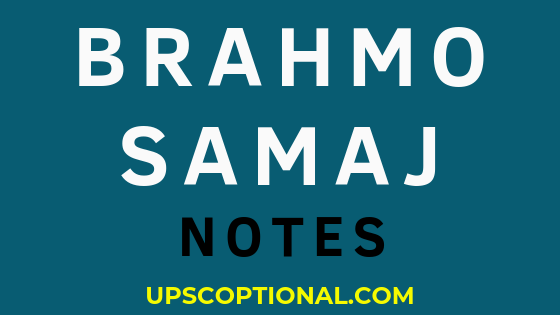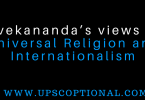Write an Introductory note on Brahmo Samaj as an important Social Movement in India.
Ans – The main teachings of the Brahmo Samaj can be summed up as enunciated by Devendranath Tagore as follows :
- In the beginning there was naught. The one Supreme alone existed. He created the whole universe.
- He alone is the God of Truth, Infinite Wisdom, Goodness and Power Eternal and Allpervading , the One without a second ( Ekamevadvitiyam ).
- In His worship lies our salvation in this world and in the next.
- Loving Him and doing that which He loveth constitute His worship.
The social thought of Brahmo Samaj can be summed up in the following words of Devendranath, “ He who desireth the good of mankind must look on others as he looks on himself. It behoves thee to love thy neighbour alone, it causes thee pain to be hated by another. Thus in all things shalt thou deal with others by comparing them with thyself; for as pleasure and pain effect thee, so do they affect all creatures. Such conduct alone is the means of attaining well-being. He who adores God and loves man, is a saint. Such a man never rejoices in finding fault with men, for man is beloved of man. He is pained by the sight of a fault in others and lovingly does he labour for its correction. He loves a man as man; and owing to that love, is pleased by the sight of good, and grieved by the sight of evil in man. Therefore, he is unable to proclaim the faults of others with rejoicing. The satisfaction of inner spirit, or, in other words, a good conscience, is the unfailing fruit of the practice of righteousness, the inner spirit is never satisfied. The mind may find enjoyment in the pleasures of the world, but if the conscience is diseased , then even the height of worldly bliss becomes valueless. Therefore, by the practice of righteousness, ye shall preserve a clear conscience, and ye shall abandon all things whereby the satisfaction of the spirit may be marred.”
The Renaissance thinkers advocated a synthetic approach to religion which was followed by contemporary Indian social thinkers. This tendency was most eloquent in the sayings of Ramakrishna. It was circulated by his able disciple Vivekananda. The same tendency was again expressed in M K Gandhi’s evening prayer where he used to recite the Quran and Bible along with Gita. Among the Renaissance thinkers Raja Ram Mohan Roy was almost the first to start this synthetic approach to religion. He was equally impressed by Bible, Quran, Upanishads and Gita. He believed in monotheism and monism though he failed to distinguish between the two. He was bitterly against sectarianism, superstition and idolatry but he did not repudiate Vedic religion. Like Spinoza he accepted substance as the ultimate reality, but unlike him he considered attributes as much necessary as the substance. Here he was more impressed by Ramanuj and Vaishnava Saints.
Keshab Chandra and his Brahmo Samaj :-
Keshab Chandra Sen, though inspired by Ram Mohan Roy differed in some of his views and therefore founded the Brahmo Samaj of India on November 11, 1866, separate from the Adi Brahmo Samaj. Like Roy, he had wide reading in religion and was impressed by the Bible, the Zend Avesta and the Quran along with the Upanishads and the Bhagavad Gita. Thus we find an electic and synthetic approach in the philosophy and religion of Keshab Chandra Sen. He considered God as a creative force and used the word God force. According to him the design and harmony witnessed in nature is a sufficient proof for the reality of the creator of the world.






